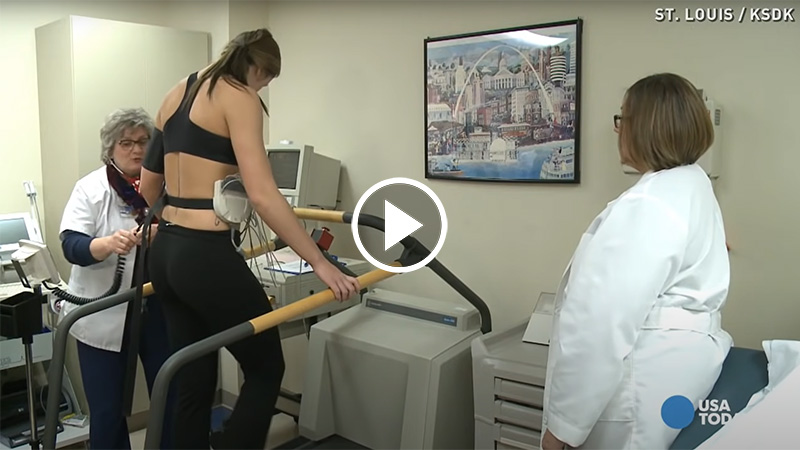You can make a huge impact on your health by staying current on all wellness visits, immunizations and recommended screenings for your age or health condition, but what about the times between preventive care visits? As we know, health issues don’t always conveniently present during a visit with a physician, and keeping an eye on your health is something that should be an everyday priority, not just once or twice a year.
These seven easy, do-it-yourself tests that you can do in the comfort of your home and without an appointment can help you keep track of your health between visits, and can even signal if you need to see your doctor sooner rather than later.
1. Palm Reading
No, we’re not talking about the kind of palm reading that comes from a psychic! If you have been feeling sluggish, or experiencing shortness of breath or a racing heartbeat, taking a look at your palms can help reveal a clue to your symptoms.
Iron is used for creating red blood cells that carry oxygen to every part of our body. If your body is not creating enough red blood cells, your skin will look paler. This can be a sign of anemia.
The test: Turn your palms upwards in front of you and stretch out your fingers, almost as if you’re reaching for something just out of touch. If the creases in your palm are pale, regardless of skin tone, this may mean you’re suffering from poor circulation in your blood vessels due to low iron levels. Make an appointment with your physician so they can order a full blood count to confirm anemia and treat it.
2. The Phalen Maneuver
Nope, this isn’t a wrestling move like it may sound. It actually has to do with what many office workers dread: carpal tunnel syndrome. Carpal tunnel is characterized by numbness and tingling in the hand caused by a pinched nerve in the wrist.
The Phalen maneuver, named after American orthopedist George S. Phalen, provides an easy diagnosis from home if you’re unsure if it’s actually carpal tunnel or not.
The test: Press the tops of your wrists together so your fingertips are facing the floor, in a reverse prayer hands position. Your elbows should be extended. Hold this position for 30 to 60 seconds.
If you begin to feel tingling, prickling or burning in your thumb, index finger, middle finger and inner part of your ring finger, then you may have early signs of carpal tunnel and it’s time to schedule an appointment with your physician.
3. The Pillow Test
Put your feet up and relax! The comfiest of the seven tests, the pillow test measures how healthy your arteries are. If you suffer from poor artery health due to peripheral artery disease, an arterial disease caused by plaque buildup, it can be hard for blood to travel through your veins and can lead to coronary heart disease or even cut off the blood supply to your limbs.
The test: Gather a few pillows or cushions and use them to prop up both legs so they’re at a 45-degree angle while you lie on your back. As you’re resting, notice if your legs become paler or retain their original color throughout the span of a minute. Once the minute is up, lower your legs down from the cushions as fast as you can, allowing them to dangle off the side of the surface you were lying on at a 90-degree angle. If your legs turned pale while propped up and took a bit to return to normal after letting them dangle, you may have blockages in your arteries and you should make an appointment with your physician right away.
4. The Door Test
Although the screening schedule differs by age, it’s generally recommended that you receive regular eye exams every 2 to 4 years unless you’re experiencing issues with your sight or you have special risk factors like diabetes or a family history of glaucoma. If you can’t remember the last time you had someone take a look at your eyes or you’re experiencing headaches or squinting to see something, it may be time to schedule an appointment, but if you’re still skeptical, you can test yourself at home first.
The test: Stand across the room (approximately 10 feet) from a door frame with a closed door and focus on the vertical and horizontal lines of the door and frame. Next, cover one eye and look at it for about 30 seconds, then repeat with the other eye, allowing time to refocus both eyes.
If any parts of the door or frame become altered, wavy or disappear while testing either eye, it may be time to get spectacles, or increase your prescription.
5. Do the Wobble
“Weebles wobble, but they don’t fall down” is a good thing for the classic children’s toy, but wobbling can be a worrying sign for everyone else, whether you fall down or not. Since wobbling or tremors can be caused by something as simple as having a little too much coffee or something more severe like anxiety, it can also be a good indicator of hyperthyroidism, or an overactive thyroid.
Although hyperthyroidism is usually accompanied by other symptoms like mood swings, fatigue and weight loss, the wobble test—along with eliminating possible causes of symptoms—can help determine if you need to schedule an appointment with the doctor.
The test: Stretch a hand out in front of you with your palm facing toward the floor. Place a piece of paper on top of your outstretched hand and watch for any movement in the paper. Since trembling can sometimes be too small to recognize, the paper helps amplify any unnoticed tremors.
6. Telling Time
Alzheimer’s is one of the leading causes of death in the U.S., and it’s also the most feared disease by Americans. If you’re worried about dementia, this easy test, which is often performed clinically, can help identify some red flags.
The test: Draw a simple clock on a piece of paper, fill in the numbers and draw the hands of the clock to read “3:40”. Now have someone take a look at your clock. Did you close the circle completely? Jot down one point. Did you write down all 12 numbers? Give yourself another point. Finally, did you place the hands correctly? Give yourself a point.
If you missed any of the three functions above, you should contact your physician to talk about getting screened for dementia.
7. Squat Down
This may be one of the most important at-home tests you can do, since researchers estimate scoring anything less than an eight on this longevity test can indicate an increase in fatality risk within the next six years.
The test: At the start of the test, assume you have 10 points. Begin the test by crossing your ankles and squatting down toward the ground until you are sitting down. Next, stand back up.
If you had to use your hands to stand back up, subtract one point from your initial 10. If you propped yourself up with another part of your body, subtract another point. If you propped yourself up with the help of two body parts, subtract two points. If you wobbled a bit, take off a point. And if you fell on your way up, take off another point. Be honest with yourself when subtracting points, or have someone watch you; after all, it’s your health at risk.
Your physician would love for you to see them regularly, whether you’re feeling ill or not, but if you haven’t seen your physician in some time or you just want to test your current health between visits, these seven tests can help you keep a finger on the pulse of your health.
If you are looking for a doctor, Texas Health Resources offers an easy-to-use tool to make your search easy. Check out our “Find a Physician” tool to find a physician near you!


